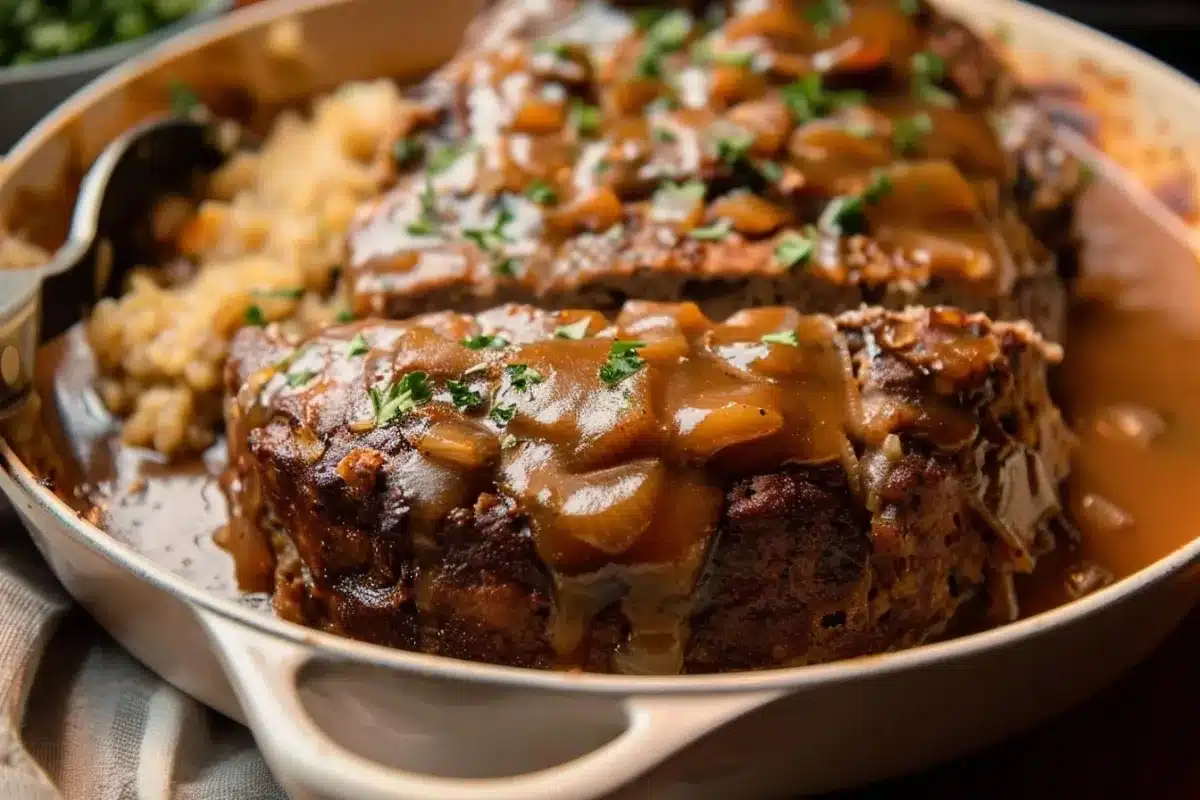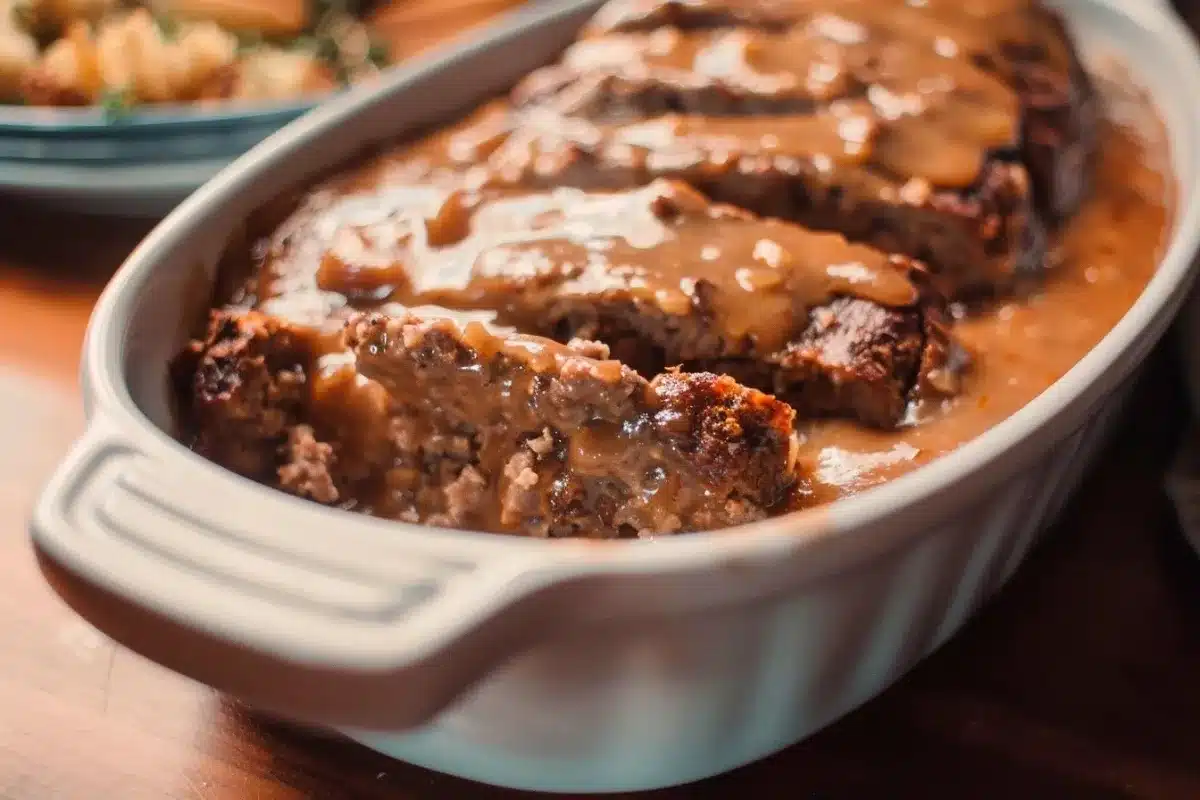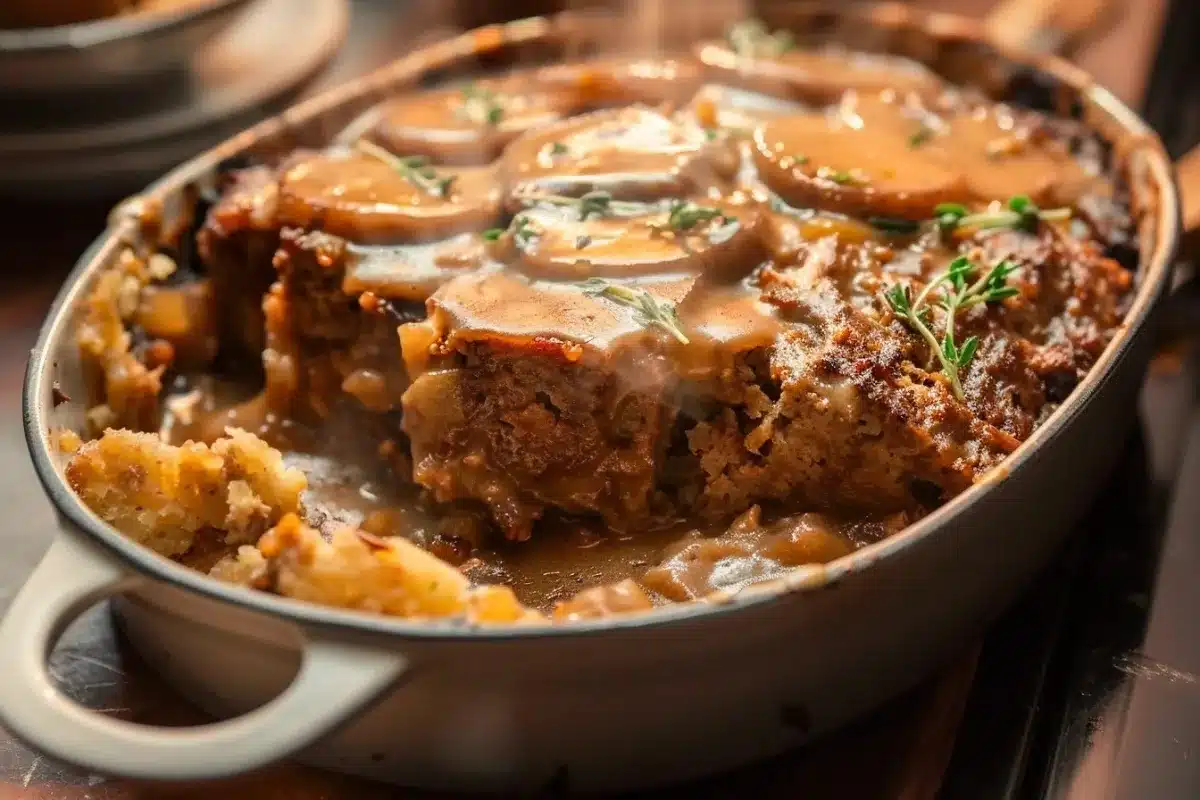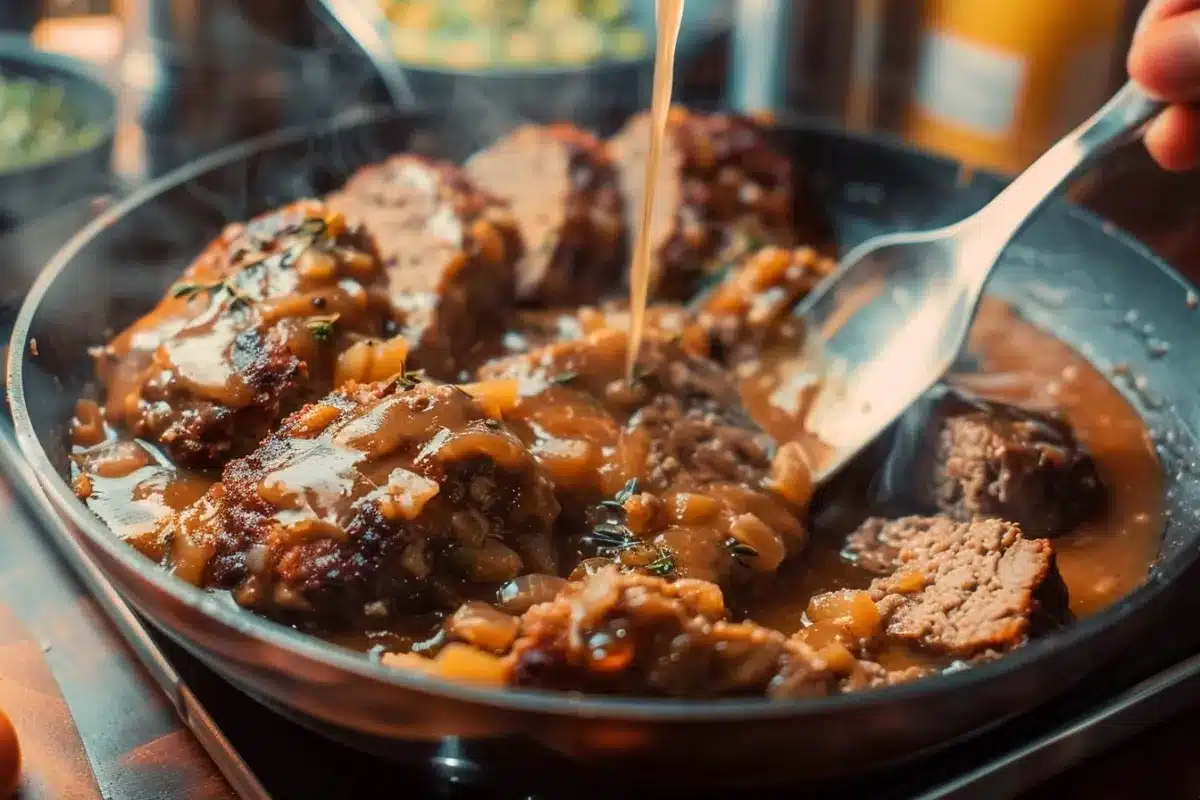Craving a rich sauce for your meatloaf? This guide shows you how to create flavorful meatloaf gravy, step by step.
Crafting the perfect meatloaf gravy can transform an ordinary meal into a comforting classic. Therefore, we will explore every detail to help you make the most delicious gravy. In this article, you will learn how to create a savory sauce that perfectly complements your meatloaf. Moreover, we’ll cover essential tips, tricks, and variations to enhance your gravy making skills.
What is Good Meatloaf Gravy?
Meatloaf gravy, when made well, adds a level of richness and moisture. Furthermore, it elevates the entire dish. Conversely, a poorly made gravy can ruin even the best meatloaf. Indeed, the key lies in understanding the foundational components and techniques.
Key Components of Flavorful Gravy
A good meatloaf gravy is generally built upon a base of pan drippings. Additionally, these drippings provide a depth of flavor. This flavorful base is further enriched with:
-
A roux (fat and flour mixture)
-
Broth or stock
-
Aromatic seasonings
Making a Simple, Savory Gravy
Firstly, gathering your ingredients is crucial. Secondly, understanding the basic process is essential. Hence, this simple approach will yield a consistently delicious meatloaf gravy.
Gathering Your Ingredients for Great Gravy
Initially, start with the pan drippings from your cooked meatloaf. Next, add butter or oil for the roux base, along with all-purpose flour. Furthermore, you’ll need beef broth or stock. Finally, include salt, pepper, and any other herbs you enjoy.
Step-by-Step Guide to Preparing Delicious Gravy
-
Strain the Drippings: After removing the meatloaf from the pan, strain the pan drippings. Moreover, this removes any solids and leaves behind flavorful fat.
-
Create the Roux: In the same pan, melt butter or oil. Additionally, whisk in the flour. Then cook it over medium heat. Stir constantly for a minute.
-
Whisk in the Broth: Gradually add the broth or stock to the roux. Also, whisk continuously. This will prevent lumps.
-
Simmer Until Thickened: Reduce the heat to low. Then let the gravy simmer until it reaches your desired consistency.
-
Seasoning: Add salt, pepper, and any additional herbs. Lastly, adjust to taste.
Exploring Variations for Excellent Gravy
While a basic gravy is lovely, exploring variations can be fun. Moreover, it allows you to adapt your meatloaf gravy to different tastes. Therefore, consider these tasty options.
Mushroom Gravy: An Earthy Option
Adding sautéed mushrooms introduces an earthy flavor to your gravy. Also, the mushrooms enhance the texture.
-
Sauté the Mushrooms: Before starting the roux, sauté sliced mushrooms in butter or oil until they soften.
-
Proceed as Usual: Then, continue with the roux and broth as you would normally.
Onion Gravy: A Sweet Addition
Sautéing onions before making the roux adds sweetness. Furthermore, the caramelization deepens the flavor profile.
-
Sauté the Onions: Cook finely chopped onions in butter until golden brown and softened.
-
Create the Roux: After this, continue with your roux. Use the same pan.
Herb-Infused Gravy: Aromatic
Fresh herbs enhance the aromatic profile of your gravy. Furthermore, they add a layer of freshness.
-
Add Fresh Herbs: Stir in finely chopped fresh herbs such as thyme, rosemary, or parsley during the final simmering stage.
Perfecting Your Made Gravy: Tips and Tricks
To ensure the best results, consider these helpful tips. Moreover, these suggestions will help you avoid common mistakes.
Achieving the Right Consistency for Savory Gravy
Achieving the correct gravy thickness is important. Therefore, here’s how to manage it.
-
Too Thick: If your gravy becomes too thick, add more broth or stock. Gradually, whisk until the desired consistency is reached.
-
Too Thin: If your gravy is too thin, simmer it for a longer period. Consequently, this allows the excess moisture to evaporate. Alternatively, you can use a small cornstarch slurry.
Preventing Lumps in Smooth Gravy
Lumps are a common problem when making gravy. However, you can avoid this by using these strategies.
-
Whisk Constantly: When adding the broth or stock, whisk constantly. This prevents the flour from clumping.
-
Gradual Addition: Pour the liquid in slowly and whisk after each addition. Also, this helps prevent lumps from forming.
Seasoning Your Delicious Gravy Correctly
Seasoning is essential to a well-rounded flavor. Furthermore, it’s best to adjust seasoning gradually.
-
Salt and Pepper First: Begin with salt and pepper. Always taste and adjust as you go.
-
Add Herbs Later: Add delicate herbs toward the end of the simmering process.
The Role of Drippings in Great Gravy
Pan drippings form the basis of a genuinely rich meatloaf gravy. Hence, it’s important to understand their importance.
Why Drippings Are Essential for Savory Flavor
-
Depth of Flavor: The drippings are full of flavors from the meatloaf. Therefore, they create a richer and more complex sauce.
-
Authenticity: Gravy made with drippings has an authentic and home-cooked feel.
-
Natural Thickeners: Drippings already contain some fat that contributes to the texture of the final product.
Using Drippings Effectively to Craft Delicious Gravy
-
Strain the Drippings: Always strain your drippings. Thus, remove any burnt bits. These could cause a bitter taste.
-
Measure the Fat: If you have a lot of fat, you may need to remove some. Use only the necessary amount for your roux.
Enhancing Your Meatloaf with Delicious Gravy
Pairing the right gravy with meatloaf is essential. Moreover, the gravy should enhance, not mask, the meatloaf’s flavor. Therefore, consider how to best complement your meatloaf.
Best Gravy Pairings for Different Meatloaf Flavors
-
Classic Meatloaf: A traditional gravy made with beef broth and drippings will be perfect.
-
Italian Meatloaf: Add some red wine or Italian herbs to your gravy for a more complementary taste.
-
Spicy Meatloaf: A tomato-based gravy with a touch of heat, such as a dash of paprika, would work well.
Plating and Serving Tips
-
Pour Over or Serve Aside: Pour gravy directly over the sliced meatloaf. Alternatively, serve it on the side for dipping.
-
Garnish: A sprinkle of fresh parsley or a sprig of thyme makes for an elegant finish.
-
Complementary Sides: Serve your meatloaf and gravy with creamy mashed potatoes or roasted vegetables.
Common Mistakes When Making Good Meatloaf Gravy
Understanding common mistakes is key. Also, knowing what to avoid will help you achieve better results. Therefore, let’s explore these potential pitfalls.
Avoiding Common Errors in Crafted Gravy
-
Not Straining Drippings: Skipping the straining step can result in a bitter gravy.
-
Burning the Roux: Cooking the roux for too long can give your gravy an unpleasant burnt flavor.
-
Lumpy Gravy: Not whisking properly or adding too much liquid at once can cause lumps.
-
Under Seasoning: Not seasoning enough makes for bland gravy.
-
Over Seasoning: Adding too much seasoning can overpower the other flavors.
Troubleshooting Your Tasty Gravy
-
Thin Gravy: If your gravy is too thin, simmer it for a bit longer. Also, you can add a cornstarch slurry if needed.
-
Thick Gravy: If your gravy is too thick, gradually whisk in more broth.
-
Lumpy Gravy: If the gravy is lumpy, pass it through a fine-mesh sieve.
Essential Equipment for Making Savory Gravy
Having the right tools makes cooking easier. Therefore, let’s explore what you’ll need to make gravy efficiently.
Basic Tools Needed for Delicious Gravy
-
Saucepan: A medium-sized saucepan is ideal.
-
Whisk: For preventing lumps during gravy preparation.
-
Measuring Cups and Spoons: For accurate ingredient measurement.
-
Fine-Mesh Sieve: For straining the drippings.
-
Spoon or Ladle: For stirring and serving.
Optional Tools to Enhance Your Gravy Making
-
Fat Separator: To easily remove excess fat from the drippings.
-
Immersion Blender: To create an ultra-smooth gravy.
Frequently Asked Questions (FAQs) About Tasty Gravy
Here are some frequently asked questions about meatloaf gravy. Also, these will help to resolve common queries.
What is the sauce on meatloaf made of?
The sauce on meatloaf usually consists of a mixture of ketchup, brown sugar, and sometimes vinegar or mustard. Conversely, meatloaf gravy typically involves pan drippings, flour, broth, and seasonings.
What is meatloaf gravy made of?
Meatloaf gravy is mainly made from the drippings left in the pan after cooking meatloaf. Also, it typically includes a roux of butter and flour, as well as broth or stock. Lastly, it is seasoned with salt, pepper, and other herbs and spices.
What do I put on top of my meatloaf?
Many things can be put on top of meatloaf. However, a simple ketchup-based sauce or a rich gravy are the most popular. Moreover, bacon slices are sometimes used.
What is the difference between Salisbury steak and meatloaf with gravy?
The primary difference lies in the presentation and cooking method. Salisbury steak is typically a single patty. Moreover, it’s served with gravy. Conversely, meatloaf is usually baked as a loaf. Additionally, it is sliced and served with or without gravy.
Table 1: Basic Gravy Ingredients
| Ingredient | Amount | Purpose |
| Pan Drippings | Variable | Foundation of flavor |
| Butter or Oil | 2 tablespoons | Base for the roux |
| All-Purpose Flour | 2 tablespoons | Thickening agent |
| Beef Broth or Stock | 2 cups | Liquid base |
| Salt | To taste | Flavor enhancer |
| Black Pepper | To taste | Flavor enhancer |
Table 2: Troubleshooting Gravy Problems
| Problem | Solution |
| Too Thick | Gradually add more broth or stock while whisking. |
| Too Thin | Simmer for longer or add a cornstarch slurry. |
| Lumpy | Whisk vigorously or pass through a fine-mesh sieve. |
| Bland | Adjust seasoning, adding salt and other herbs. |
| Burnt Flavor | Start over with fresh drippings and a new roux. |
Advanced Techniques for Exceptional Gravy
Beyond the basics, several advanced techniques can take your meatloaf gravy to the next level. Therefore, let’s explore these options for achieving an even more refined sauce.
Deglazing the Pan: Adding Depth of Flavor
Deglazing the pan involves using a liquid to dissolve the flavorful bits that stick to the bottom of the pan after cooking. Furthermore, this step significantly enhances the richness and complexity of your gravy.
-
Remove Excess Fat: After removing the meatloaf and straining the drippings, carefully remove any excess fat from the pan.
-
Add Liquid: Over medium heat, add a splash of red wine, beef broth, or even a bit of water to the pan.
-
Scrape and Reduce: Scrape the bottom of the pan with a spoon or spatula, loosening all the flavorful browned bits. Then allow the liquid to reduce slightly. Incorporate this flavorful base into your gravy.
Using Mirepoix for a Flavorful Base
A mirepoix, a combination of diced onions, carrots, and celery, adds depth and sweetness to your gravy base. Indeed, it is a classic technique used in many sauces.
-
Sauté the Mirepoix: In the pan, sauté the diced onions, carrots, and celery in butter until they become soft and fragrant.
-
Proceed with Roux: Add the butter and flour to make the roux as usual, then proceed with your gravy preparation.
Incorporating Umami-Rich Ingredients for Savory Gravy
Adding umami-rich ingredients can greatly enhance the savoriness of your gravy. Moreover, these additions bring a deep, satisfying flavor that elevates the dish.
-
Soy Sauce: A dash of soy sauce provides a salty, savory note.
-
Worcestershire Sauce: A small amount of Worcestershire sauce adds complexity and depth.
-
Tomato Paste: Adding a teaspoon of tomato paste brings a rich umami flavor and a touch of sweetness.
Slow Cooking the Gravy for Maximum Flavor
Allowing the gravy to simmer for a longer period on low heat allows the flavors to meld together. Also, the sauce becomes even richer and more flavorful.
-
Simmer Slowly: After adding all of the ingredients, reduce the heat to low and let the gravy simmer for at least 30 minutes.
-
Stir Occasionally: Stir occasionally to prevent sticking and to ensure even flavor development.
Adding a Touch of Cream for Extra Richness
A small amount of heavy cream or half-and-half at the end of cooking adds a luxurious touch to your gravy. Furthermore, it makes it richer and smoother.
-
Stir in Cream: Right before serving, stir in a tablespoon or two of heavy cream or half-and-half. Do not boil the gravy after adding cream.
Storing and Reheating Your Made Gravy
Knowing how to properly store and reheat gravy is essential. Therefore, here are some helpful tips.
Storing Delicious Gravy
-
Cool Completely: Allow the gravy to cool completely before storing it.
-
Airtight Container: Store the gravy in an airtight container in the refrigerator for up to 3-4 days.
-
Freezing: Gravy can also be frozen for longer storage. Use a freezer-safe container. It is best to thaw gravy in the refrigerator overnight before reheating.
Reheating Good Gravy
-
Stovetop: Gently reheat the gravy in a saucepan over low heat. If it is too thick, add a bit of broth or stock while reheating.
-
Microwave: Alternatively, reheat in the microwave, stirring every 30 seconds to ensure even heating.
Understanding the Science Behind Great Gravy
The process of making gravy is also a science. Therefore, a better understanding of the underlying principles can improve your techniques.
The Role of the Roux in Thickening Gravy
-
Fat and Flour: The roux, a mixture of fat and flour, is crucial. The fat coats the flour molecules. This action prevents them from clumping when they come into contact with liquid.
-
Cooking the Roux: Cooking the roux for a short period creates a nutty flavor and helps to eliminate any raw flour taste. Also, the degree to which it is cooked affects its thickening power.
How Heat Affects Gravy Consistency
-
Simmering: Simmering the gravy allows the liquid to evaporate. Moreover, this action thickens the gravy.
-
Too Much Heat: Too high heat can cause the gravy to thicken too quickly. Therefore, it’s best to simmer over low heat for the best texture.
Creative Ideas for Using Leftover Tasty Gravy
Leftover gravy can be repurposed in several ways. Indeed, this prevents food waste. Moreover, it allows for some fun meal experimentation.
Gravy as a Base for Other Sauces
-
Pot Pie Filling: Use leftover gravy as a base for a pot pie filling. Add vegetables and cooked meat.
-
Shepherd’s Pie: Combine gravy with cooked ground meat to create a tasty shepherd’s pie filling.
Using Gravy in Other Dishes
-
Poutine: Drizzle leftover gravy over fries and cheese curds.
-
Breakfast Hash: Stir gravy into a breakfast hash. This will add moisture and flavor.
The Importance of Quality Ingredients for Delicious Gravy
Using good ingredients will make a big difference. Furthermore, quality ingredients enhance the flavor and texture of your gravy.
Selecting the Best Broth or Stock
-
Homemade: Homemade broth or stock is always the best.
-
Low Sodium: If using store-bought, opt for low-sodium options. This gives you greater control over the salt content.
-
Flavorful: Choose broth or stock that has a rich, deep flavor.
Choosing the Right Herbs and Spices
-
Fresh Herbs: Fresh herbs bring a bright, aromatic quality.
-
Dried Herbs: If using dried herbs, use about one-third of the amount called for with fresh.
-
Quality Spices: Use fresh spices. Make sure that they have a strong aroma.
Conclusion: Enjoy Your Crafted Gravy
Mastering the art of meatloaf gravy is rewarding. Furthermore, it enhances your meatloaf. By following these tips and techniques, you can consistently produce a delicious, rich gravy that everyone will love. Therefore, take your time, enjoy the process, and savor the results of your labor.



